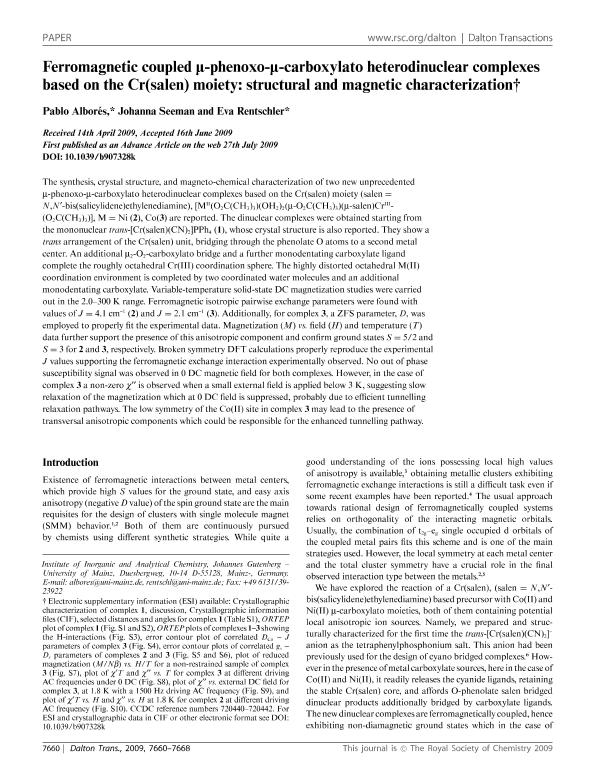Artículo
Ferromagnetic coupled μ-phenoxo-μ-carboxylato heterodinuclear complexes based on the Cr(salen) moiety: Structural and magnetic characterization
Fecha de publicación:
09/2009
Editorial:
Royal Society of Chemistry
Revista:
Dalton Transactions
ISSN:
0300-9246
Idioma:
Inglés
Tipo de recurso:
Artículo publicado
Clasificación temática:
Resumen
The synthesis, crystal structure, and magneto-chemical characterization of two new unprecedented μ-phenoxo-μ-carboxylato heterodinuclear complexes based on the Cr(salen) moiety (salen = N,N′-bis(salicylidene)ethylenediamine), [MII(O2C(CH3)3)(OH2)2(μ-O2C(CH3)3)(μ-salen)CrIII(O2C(CH3)3)], M = Ni (2), Co(3) are reported. The dinuclear complexes were obtained starting from the mononuclear trans-[Cr(salen)(CN)2]PPh4 (1), whose crystal structure is also reported. They show a trans arrangement of the Cr(salen) unit, bridging through the phenolate O atoms to a second metal center. An additional μ2-O2-carboxylato bridge and a further monodentating carboxylate ligand complete the roughly octahedral Cr(III) coordination sphere. The highly distorted octahedral M(II) coordination environment is completed by two coordinated water molecules and an additional monodentating carboxylate. Variable-temperature solid-state DC magnetization studies were carried out in the 2.0–300 K range. Ferromagnetic isotropic pairwise exchange parameters were found with values of J = 4.1 cm−1 (2) and J = 2.1 cm−1 (3). Additionally, for complex 3, a ZFS parameter, D, was employed to properly fit the experimental data. Magnetization (M) vs. field (H) and temperature (T) data further support the presence of this anisotropic component and confirm ground states S = 5/2 and S = 3 for 2 and 3, respectively. Broken symmetry DFT calculations properly reproduce the experimental J values supporting the ferromagnetic exchange interaction experimentally observed. No out of phase susceptibility signal was observed in 0 DC magnetic field for both complexes. However, in the case of complex 3 a non-zero χ″ is observed when a small external field is applied below 3 K, suggesting slow relaxation of the magnetization which at 0 DC field is suppressed, probably due to efficient tunnelling relaxation pathways. The low symmetry of the Co(II) site in complex 3 may lead to the presence of transversal anisotropic components which could be responsible for the enhanced tunnelling pathway.
Archivos asociados
Licencia
Identificadores
Colecciones
Articulos(INQUIMAE)
Articulos de INST.D/QUIM FIS D/L MATERIALES MEDIOAMB Y ENERGIA
Articulos de INST.D/QUIM FIS D/L MATERIALES MEDIOAMB Y ENERGIA
Citación
Alborés, Pablo; Seeman, Johanna; Rentschler, Eva; Ferromagnetic coupled μ-phenoxo-μ-carboxylato heterodinuclear complexes based on the Cr(salen) moiety: Structural and magnetic characterization; Royal Society of Chemistry; Dalton Transactions; 37; 9-2009; 7660-7668
Compartir
Altmétricas




